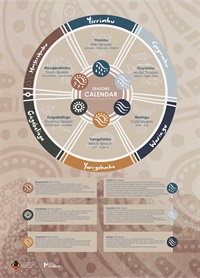Aboriginal cultural heritage
The information on this page was contributed by the Tweed Shire Council Aboriginal Advisory Committee.
Aboriginal sites and places are recognised by traditional custodian descendants as tangible evidence of our ancestors’ cultural practice and traditions; as such, they retain a very real and meaningful value through to the present day.
History Cultural sites & places Working with community

Seasons calendar
Tweed Byron Local Aboriginal Land Council, in collaboration with Tweed Regional Museum, developed this 6 season cultural calendar.
In collaboration with the local Aboriginal community, it uses cultural knowledge to represent seasonal markers throughout a year.
Our history
Scientific assessment of cultural evidence from some selected sites supports the fact that Aboriginal people were living in the Tweed from at least 10,000 years ago, and a Carbon-14 dated midden and occupation site on Stradbroke Island (in South East Queensland) is recorded as more than 20,000 years old.

Map: First People of the Tweed Valley. Courtesy of Ian Fox
Our Aboriginal oral tradition tells a story of ‘Three Brothers’ who came to this land and its people in the ‘Dreaming’, gave the lore, and formed the nucleus of tribes with whom today’s traditional custodian descendants identify.
Language
A common feature of our Aboriginal identity is language, which is known in the Tweed and further south as Bundjalung; in south east Queensland people prefer Yugambeh; and further west, in Kyogle Shire, people use Githabul as both a language and name for group identification.
The language dialect for the Tweed is known as Ngandowal, a name referring to the people who say ‘Ngando’ for the word ‘who’ or ‘somebody’. However, part of the Tweed Coast and south to the Byron area is Minyungbal, where the word ‘Minyung’ means ‘what’ or ‘something’ and can be used as identification for people of this area.
Groups
There is general acceptance among our Tweed Aboriginal community for the presence of 3 main groups in the Tweed Valley.
These were the Goodjinburra people for the Tweed Coastal area, the Tul-gi-gin people for the North Arm, and the Moorang-Moobar people for the Southern and Central Arms around Wollumbin (Mt Warning).
However, European settlers used other names and described them as Chubboburri, Gandowal, Duthurinbar, Wirangiroh, Wollumbin, Murwillumbah, Ngarrumbul, Kitabul, and Ngarartbul. These names largely reflected a lack of understanding of our culture, our language and our connection to each other.
Population numbers of these 3 groups are known to have fallen dramatically, before and after permanent European settlement, mainly through the unchecked spread of European sourced illness and disease. Research suggests that prior to any European contact each of the 3 groups may have contained from 500 to 700 members, distributed in smaller family groups across what was then their area of ‘country’.
With a loss of access to food resources, death from illness and disease, and intolerance shown by some European settlers, population numbers plummeted and were only about 10% of original numbers within 60 years of settlement.
Resources
The Tweed Valley around Wollumbin (Mt Warning) was rich in natural resources and supported many plants and animals which were collected and hunted for food by Aboriginal people.
Traditional people managed the landscape and avoided overexploiting these resources in a way that is poorly understood and little recognised in today’s wider community. Although camp locations were moved regularly to allow resource recovery some natural resources, such as rock outcrops suitable for the manufacture of stone tools, were used extensively for vast periods of time.
Places
High altitude topographical features were often the focus of social and spiritual custom and the location of many of our Aboriginal sites directly reflects the connection and significance value of these places.
Wollumbin retains a high cultural and spiritual status beyond the Tweed Valley and this is reinforced by our knowledge of different stories with regional group gatherings for ceremony and cultural expression at certain sites across the Valley. Descendants of traditional custodians maintain that connection and support initiatives to protect and preserve our heritage sites and places.
Cultural sites and places in today’s landscape
We retain levels of cultural confidentiality within our Aboriginal community and we may prefer that certain site details and exact locations are not disclosed.
Landowners who have recorded sites on their property are encouraged to respect our cultural traditions. Traditional custodian descendants make no claim to own land, but simply ask to be informed about unrecorded sites. Cultural tradition includes a protocol for information access concerning certain recorded sites and the contact procedure given below should be followed.
The Tweed/Byron Local Aboriginal Land Council (TBLALC) is also willing to provide property owners with advice concerning the possible occurrence of Aboriginal sites and measures to protect and preserve the several hundred known and identified sites within the Tweed.
Additionally, the Office of Environment and Heritage have a legislated responsibility to record Aboriginal sites and places and this is undertaken through the National Parks and Wildlife Service (NPWS) database known as the Aboriginal Heritage Information Management System (AHIMS).
Should any Aboriginal sites or artifacts be located, then in accordance with legislation, the NPWS Northern Rivers Region Aboriginal Heritage Conservation Officer (02 6627 0205), should be advised.
The TBLALC may also assist with advice on site registration.
Working with the community
Council employs a Community Development Officer – Aboriginal to work with the Aboriginal and Torres Strait Islander community.
To contact a member of the Community Development Team, please call 02 6670 2400 or email tsc@tweed.nsw.gov.au.
Other contacts